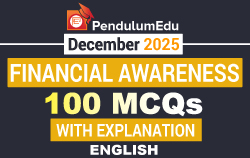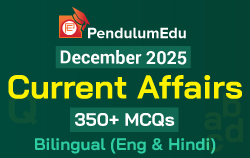Daily Current Affairs and GK | 16 May 2025

Main Headlines:
- 1. Indian government has officially set 23rd September as the annual date for Ayurveda Day.
- 2. Former Uruguay President Jose Mujica passed away at the age of 89.
- 3. The 2025 World Food Prize awarded to a Brazilian microbiologist for her contributions to environmentally friendly agriculture.
- 4. India successfully test-fired the indigenous 'Bhargavastra' counter-swarm drone system.
- 5. Denmark launched the first commercial-scale e-methanol plant to promote green shipping.
- 6. A successful 'Teesta Prahar' exercise conducted by the Indian Army.
- 7. India and the European Union have launched two major joint research programs under the India-EU Trade and Technology Council (TTC).
- 8. DRDO has developed a new indigenous membrane for seawater desalination.
- 9. The Ministry of Statistics and Programme Implementation has released the first Monthly Bulletin of the updated Periodic Labour Force Survey (PLFS) for April 2025.
- 10. India is expected to grow by 6.3 per cent this fiscal year.
Happy New Year get 35% Off
Use Coupon code NY2026
Topic: Important Days
1. Indian government has officially set 23rd September as the annual date for Ayurveda Day.
- This change has been implemented through the gazette notification issued on 23 March 2025.
- Previously, Ayurveda Day was celebrated on Dhanteras, which follows a variable lunar calendar.
- The goal of Ayurveda Day is to promote Ayurveda as a scientific, evidence-based healthcare system.
- The date of Dhanteras changes each year, making it difficult to have a fixed date for Ayurveda Day.
- The Ministry of Ayush pointed out that Dhanteras would continue to vary between 15th October and 12th November.
- This inconsistency created challenges for organizing consistent national and international events.
- To address this, the Ministry of Ayush formed a committee to suggest a suitable date.
- The committee reviewed several options and chose 23rd September as the best choice.
- This date coincides with the autumnal equinox, when day and night are nearly equal in length.
- The equinox symbolizes balance in nature, which aligns with Ayurveda’s emphasis on harmony.
- The equinox represents cosmic balance, reflecting Ayurveda's belief in harmony between mind, body, and nature.
- The Ministry of Ayush encourages individuals, health professionals, and international organizations to celebrate Ayurveda Day on 23rd September each year.
Topic: Personality in News
2. Former Uruguay President Jose Mujica passed away at the age of 89.
-
The straight-talking Mujica, known to many Uruguayans by his nickname "Pepe", led the small agricultural country's leftist government from 2010 to 2015.
- As president, Mujica took a leading liberal stance on issues related to civil liberties.
- He signed legislation allowing gay marriage and abortion in the early stages of pregnancy and supported a proposal to legalize the sale of marijuana.
- Mujica once led the Tupamaros rebel group and spent 15 years in prison, much in solitary.
- At 74, Mujica was elected president with 52% of the vote, despite concerns about his age and past as a Tupamaros rebel leader.
- His tenure was praised for prioritizing social justice and democratic values.

(Source: DD News)
| Monthly Current Affairs eBooks | |
|---|---|
| April Monthly Current Affairs 2025 | March Monthly Current Affairs 2025 |
| February Monthly Current Affairs 2025 | January Monthly Current Affairs 2025 |
Topic: Awards and Prizes
3. The 2025 World Food Prize awarded to a Brazilian microbiologist for her contributions to environmentally friendly agriculture.
- Brazilian scientist Mariangela Hungria has been honoured with the 2025 World Food Prize for her groundbreaking contributions to sustainable agriculture.
- She has been awarded for his pioneering work in developing organic seeds and soil treatments to reduce the use of chemical fertilizers and increase crop yield and nutrition.
- The award, carrying a $500,000 prize, was conferred by the World Food Prize Foundation on May 13, 2025.
- Over a 40-year career at Embrapa, Hungria pioneered the development of biological seed and soil treatments to reduce the use of synthetic fertilisers.
- National soybean production in Brazil rose from 15 million tonnes (1979) to 173 million tonnes due to the adoption of her innovations.
- Farmers in Brazil are estimated to save $40 billion annually through her biological nitrogen fixation techniques.
- This technology is a natural process in which naturally occurring microorganisms convert atmospheric nitrogen into forms that plant roots can absorb from the soil, reducing the need for synthetic fertilizers.
- Hungria's research on rhizobia bacteria demonstrated that annual inoculation of soybeans could yield up to 8% more than synthetic fertiliser use.
- She developed over 30 microbial technologies, which included microbial inoculants to increase productivity in soybeans, maize, rice, beans, and wheat.
Topic: Defence
4. India successfully test-fired the indigenous 'Bhargavastra' counter-swarm drone system.
- The new low-cost counter-swarm drone system. ‘Bhargavastra’ has been successfully tested by Solar Defence and Aerospace Limited (SDAL) in Gopalpur.
- The trials were conducted in the presence of Army Air Defence officials at the Seaward Firing Range.
- Bhargavastra, operating in hard-kill mode, is capable of neutralising incoming drones at a distance of up to 2.5 km.
- Unguided micro-rockets form the first layer of the system, with a lethal radius of 20 metres, tested effectively during the demonstration.
- A guided micro-missile layer had been previously tested to offer precise drone neutralisation.
- The system has been designed to operate across various terrains, including high-altitude regions above 5,000 metres.
- Indigenous and modular in design, Bhargavastra allows for the addition of soft-kill features like jamming and spoofing.
- The C4I-based Command-and-Control Centre integrates radar detection and Electro-Optical Infrared sensors for precise targeting.
- The radar component can detect threats within a 6 to 10 km range, offering full layered air defence coverage.
Topic: International News
5. Denmark launched the first commercial-scale e-methanol plant to promote green shipping.
-
On 13 May, the world’s first commercial e-methanol plant was inaugurated in Kasso, Denmark, aimed at providing green fuel to the shipping sector.
- Jointly developed by European Energy and Mitsui, the new plant will produce 42,000 metric tons, or 53 million liters, of e-methanol per year.
- The new plant is estimated to cost 150 million euros ($167 million).
- The plant’s annual output is sufficient to fuel one large 16,000-container vessel on a round trip between Asia and Europe.
- Maersk will be a major customer, as it operates 13 dual-fuel methanol container vessels powered by fuel oil and e-methanol and has ordered 13 more such vessels.
- E-methanol, unlike conventional methanol, is produced using renewable energy and CO2 captured from biogas plants and waste incineration.
- Drugmaker Novo Nordisk and Lego will also use e-methanol for manufacturing injection pens and plastic bricks, respectively.
- Excess heat generated from e-methanol production will be used to heat 3,300 homes in the local area.
Topic: Defence
6. A successful 'Teesta Prahar' exercise conducted by the Indian Army.
- On 15 may, a large-scale integrated field exercise titled 'Teesta Prahar' was successfully conducted at the Teesta field firing range by the Indian Army.
- It demonstrated operational readiness and coordination between combat and support forces in riverine areas.
- The operation focused on combat coordination among Infantry, Artillery, Armoured Corps, Para Special Forces, Engineers, and other arms.
- Newly inducted next-generation weapons, systems, and platforms were deployed and validated during the drill.
- The Army demonstrated its capacity for swift deployment in riverine terrain and adverse weather conditions.
- Additionally, an indigenous nanoporous multilayered polymeric membrane for high-pressure seawater desalination was successfully developed by DRDO.
- The Defence Materials Stores and Research & Development Establishment (DMSRDE), a Kanpur-based laboratory of DRDO, developed technology for a desalination plant in Indian Coast Guard (ICG) ships.
- This technology addresses the serious challenge of stability when exposed to chloride ions in saline water based on operational requirements.
- DMSRDE and ICG successfully conducted initial technical trials on the existing desalination plant of ICG's Offshore Patrol Vessel (OPV).
Topic: National News
7. India and the European Union have launched two major joint research programs under the India-EU Trade and Technology Council (TTC).
- The total investment for these initiatives is ₹391 crore (approximately €41 million).
- The projects focus on combating marine pollution and producing green hydrogen from organic waste.
- These efforts aim to advance innovation in environmental protection and clean energy.
- The TTC was established in 2022 by Prime Minister Narendra Modi and European Commission President Ursula von der Leyen.
- It serves as a platform to strengthen cooperation in trade and technology between India and the EU.
- The first project targets marine pollution and is co-funded by the EU and India’s Ministry of Earth Sciences.
- It aims to develop tools to monitor, assess, and reduce pollutants such as microplastics, heavy metals, and toxic organics in the ocean.
- The initiative supports global efforts like the UN Decade of Ocean Science and aligns with India’s National Marine Litter Policy and the EU’s Zero Pollution Action Plan.
- India’s Principal Scientific Adviser, Professor Ajay Kumar Sood, stated that global environmental issues require collaborative research.
- EU Ambassador Hervé Delphin said the projects reflect deepening EU-India cooperation on global challenges.
- The second project focuses on producing green hydrogen from agricultural, municipal, and industrial waste.
- It is backed by the EU and India’s Ministry of New and Renewable Energy.
- The project aligns with the EU Hydrogen Strategy and India’s National Green Hydrogen Mission.
- Calls for research proposals under both projects have been officially opened.
Topic: Defence
8. DRDO has developed a new indigenous membrane for seawater desalination.
- The membrane is nanoporous and multilayered, made from advanced polymers.
- It is designed to operate under high pressure.
- The innovation was created by DMSRDE, a DRDO lab based in Kanpur.
- The technology was developed to meet the Indian Coast Guard’s specific needs.
- It addresses the problem of instability caused by chloride ions in salty water.
- The development was completed in just eight months.
- Initial trials were conducted on a desalination unit aboard an Offshore Patrol Vessel (OPV).
- These tests were carried out jointly by DMSRDE and the Indian Coast Guard.
- The membrane passed early performance and safety evaluations.
- Final clearance will be granted after 500 hours of operational testing.
- The membrane is currently being tested on an OPV.
- With minor changes, it could be used for water purification in coastal regions.
- This breakthrough contributes to the Aatmanirbhar Bharat initiative.
- It reduces reliance on imported desalination technologies.
- DRDO is the research and development wing of the Ministry of Defence.
- Its mission is to create advanced defence technologies for India.
- DRDO aims to equip the armed forces with modern and self-reliant systems.
- It works to fulfill the needs of the Army, Navy, and Air Force through indigenous innovation.
- Defence Materials Stores and Research and Development Establishment (DMSRDE) is a Kanpur-based laboratory of DRDO.
Topic: Reports and Indices
9. The Ministry of Statistics and Programme Implementation has released the first Monthly Bulletin of the updated Periodic Labour Force Survey (PLFS) for April 2025.
- The report presents revised employment and unemployment data using the new survey framework.
- It includes indicators like Labour Force Participation Rate (LFPR), Worker Population Ratio (WPR), and Unemployment Rate (UR).
- These figures are based on the Current Weekly Status of people aged 15 and above.
- The national LFPR in April 2025 was 55.6 per cent. Rural areas reported a LFPR of 58.0 per cent.
- Urban areas recorded an LFPR of 50.7 per cent. Male LFPR was 79.0 per cent in rural regions.
- In urban areas, male LFPR stood at 75.3 per cent. Female LFPR in rural regions was 38.2 per cent.
- The national WPR was 52.8 per cent. Rural WPR was higher at 55.4 per cent. Urban WPR was recorded at 47.4 per cent.
- The WPR for rural women was 36.8 per cent. In urban areas, the female WPR was 23.5 per cent.
- Overall, the female WPR stood at 32.5 per cent.
- The unemployment rate for individuals aged 15 and above was 5.1 per cent.
- Male unemployment was slightly higher at 5.2 per cent. Female unemployment stood at 5.0 per cent.
- These figures are the first released under the revamped PLFS methodology.
- The new system was introduced in January 2025. It uses a rotational panel design to gather data.
- Each selected household is visited once a month for four consecutive months.
- There is a 75 per cent overlap in first-stage sampling units from one month to the next.
- This approach increases the consistency and comparability of data.
- In April 2025, the survey covered 7,511 first-stage sampling units.
- Out of these, 4,140 were in rural areas. The remaining 3,371 were in urban areas.
- A total of 89,434 households were surveyed nationwide.
- The survey reached 3,80,838 individuals. Of these, 2,17,483 were from rural areas. Another 1,63,355 were from urban areas.
- The redesigned PLFS now provides quarterly labour data for rural India.
- Previously, quarterly estimates were only available for urban areas.
- The sample size per unit was increased from 8 households to 12.
- This change enhances the scope and depth of the survey.
Topic: Indian Economy
10. India is expected to grow by 6.3 per cent this fiscal year.
- This makes it the fastest-growing large economy.
- The UN’s mid-year update on the World Economic Situation and Prospects (WESP) projects India’s growth to slightly rise to 6.4 per cent next year.
- However, this is 0.3 per cent lower than the January projection.
- The UN report warns that the global economy is at a "precarious moment."
- This is due to rising trade tensions and uncertain policies.
- The WESP report showed that global economic prospects have worsened since January.
- India’s growth contrasts with the global rate of 2.4 per cent and the performance of other major economies.
- China is projected to grow by 4.6 per cent, and the US by 1.6 per cent.
- Germany’s economy is expected to shrink by -0.1 per cent.
- Japan’s growth is forecast at 0.7 per cent, and the EU’s growth rate is 1 per cent.
- India’s economic growth is driven by strong private consumption, public investment, and growing services exports.
- Inflation in India is expected to decrease from 4.9 per cent in 2024 to 4.3 per cent in 2025. This is within the central bank’s target range.
- Unemployment in India remains stable amid steady economic conditions.
- However, the report points to persistent gender disparities in employment.
- It stresses the need for more inclusivity in workforce participation.
- The WESP also highlighted risks to India’s export sector from potential US tariffs.
- Certain sectors, such as pharmaceuticals, electronics, semiconductors, energy, and copper, are currently exempt from these tariffs.
- However, these exemptions may not last.
- The IMF has projected India’s economy will grow by 6.2 per cent this year and 6.3 per cent next year.





 15 May 2025 Current Affairs
15 May 2025 Current Affairs 








Comments